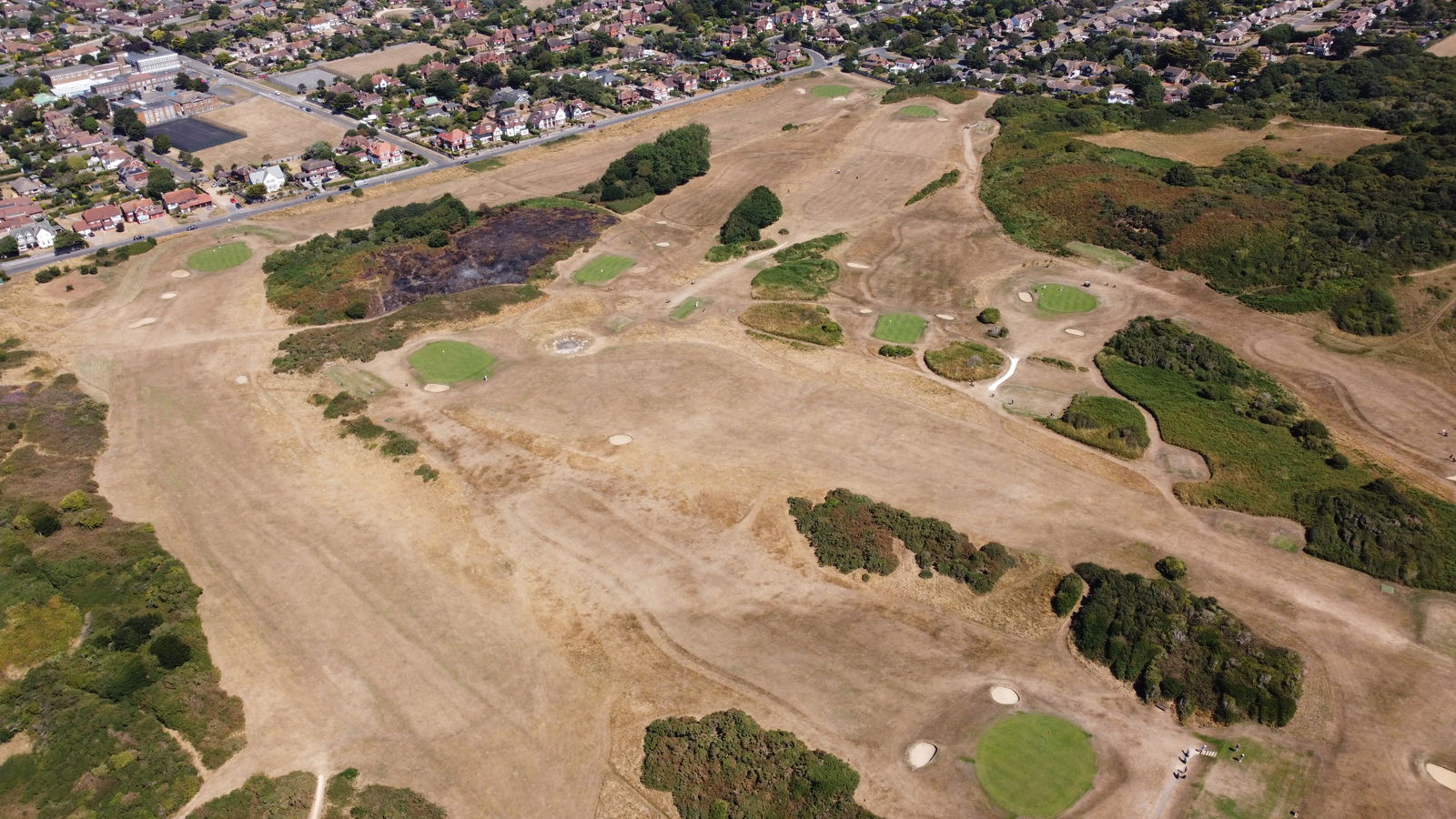Could golf courses cope with a hosepipe ban? "It would become rather difficult"
GolfMagic speaks to Simon Lambert, the Head Greenkeeper of Seaford Head, to learn more about his day-to-day running of the golf course in light of England experiencing its driest July since 1935.

Although there is a temporary hosepipe ban in place in some regions of the UK, golf courses remain exempt at present.
While that is one positive for greenkeepers up and down the nation following one of the driest summers in Britain for years, there is still a huge task at hand for them to maintain golf courses to the highest possible levels this summer and beyond.
So what impact does a drought have on a golf course, exactly?
GolfMagic teamed up with BIGGA this week to speak to Simon Lambert, the Head Greenkeeper at Seaford Head in Sussex, to learn more about how extreme temperatures affect his team's day-to-day running of the golf course.
Incredibly, they have not had to cut their fairways in FOUR weeks!
At Seaford Head, a municipal golf course owned by Seaford Town Council, they do not use mains water and instead use water abstracted from a borehole (this water is not suitable for human consumption).
Simon also spoke to us about managing fuel during an energy and fuel crisis, the impact a hosepipe ban would have on his golf course if that came into play, and how his club has dealt with multiple wildfires this month.

How do extreme temperatures impact your normal daily activity on the golf course?
Irrigation and water are constantly on my mind. The first thing I'll do in the morning is check the irrigation has gone off at night when it should have. I check the tank is filling and if it is, that’s a good sign that it has gone off. We have a computer-controlled system, Gemini, which I can check to make sure all the greens have been watered or if there have been any faults.
We're lucky that we have a borehole so we're not using mains water for any of the course. We had a new pumphouse, borehole and tank a couple of years ago but without an extraction licence we can only take 20 cubic metres a day. I don't water every day and I'd rather let it dry out for a few days, keep the surface dry, and then do the same again. We've increased the size of our tank to four times what we used to have so we can extract 20 cubic metres over a period of three or four days to give us enough to water to do that.
At the moment we're hand watering on Monday, Wednesday and Friday, which takes three or four hours every morning to handle in front of the golf. We're quite a windy site so although we can adjust which side of the greens we water, the wind really does affect where it gets to. Rather than wasting water, hand watering allows us to get the entire green.
We're obviously in a cost of living crisis right now, but have you managed to make some fuel savings?
We’re saving a lot of money on fuel, which is nice because we're paying a lot of money for it. A year ago, I paid 70p a litre for red diesel. Our last order was in July and I paid £1.20, so not far off double. I’m writing a report for our quarterly meetings and I’ll put that in there with regards the budget setting for this year because even with this drought, we’re looking like we’ll go over on fuel costs.
We cut on a need-to basis. We don't have a set routine as such, but it generally means fairways, tees and aprons twice a week, sometimes three times for the surrounds, and greens every day. Semi rough once or twice a week and rough once a week.
We have not cut the rough or the fairways for four weeks. We've done a bit of semi-rough around the greens on some of the banks where the water is hitting, just to keep those areas tidy. We've also opened up a few other areas purely with the fire risks that we've had. We've made little gaps and firebreaks and the golfers are pleased because we have a lot of areas of uncut rough that are just cut and baled once a year and these are now clearer and thinner, so they’re finding their balls a more often.
How important is sustainability for you?
In everything we do here, we try to be sustainable. We don't use any chemicals other than Revolution, a wetting agent. Our approach to watering is about specifically targeting where we want it and it's nice to see on the drone pictures that it is working.
We have wildflower areas planted with seed mixes, we use borehole water, we’re part of Operation pollinator and it all goes hand in hand. It's more challenging and sometimes I wish I could reach for a bottle of something, but this site wouldn't be the same if I did. We are a SSSI for chalk grassland so on half of the course we can't use weed killers or any products and rather than fighting against that, we've adopted that strategy all over to keep it consistent.
The biggest problem we've had is leatherjackets and pests. We get a lot of crow activity on the greens because that's the only soft place they can get their beaks in to reach the leatherjackets.

There is an exemption to the hosepipe ban that allows sports venues, including golf clubs, to continue watering their surfaces. If that wasn’t the case, how difficult would life become for you?
Depending on the temperatures, it would become rather difficult. We’re lucky in that our approach to maintenance has enabled us to get fine grasses into the greens. Some of the greens would fare better than others, certainly at the top of the course where it is the chalk downland and the grasses are naturally finer. They would survive longer than down the other end of the course where we have a lot more poa about. But we’d raise the height of cut on the greens and reduce the frequency of cuts. It would be noticeable to the golfer that we've done that, but it would keep consistency throughout the course and prevent excessive damage from drying out.
We're lucky that we're using the borehole so we've got our own supply. We’re got chalk aquifers that we drill into and it appears the supply is OK and the water is very clean. We’ve got mains backup just in case, but I really don’t want to turn that on if I don’t need to. The quality of the water benefits the greens as well and we've seen a better response from the products we use and a better response from the grass from using the borehole water than what we used to see from the mains water.
Have you had any experience of wildfires?
In the last two weeks, we've had three separate occasions of fire. We've called them wildfires, because although there may have been a human aspect to it, there's been no proof of that. I’ve worked at Seaford Head for 22 years and I live in the town, so a lot of people know I’m here and I think I got nine phone calls on the first occasion, from people telling me the course was on fire. Obviously the first thing you do is panic and the second is think right, I’ll go have a look. The first time the roads were closed below the golf course. There were two fire engines on the road and two 4x4 fire engines that worked really hard, shuttling the water up and down and managed to put the area out.
The second time they took a different approach and decided where they didn't want the fire to go and let the rest of it burn. At that point they were able to get more engines onto the course so we had four full-sized fire engines and two 4x4 fire engines positioned around the area they were containing. That seemed to work quite well in the fact that nothing's reignited in that area since they let it burn through. Because there were no buildings or people in danger, they didn't put themselves in danger trying to fight a wildfire.
They were respectful of the course and they did a great job so I can’t thank them enough. There’s still a really strong smell of the fire around the course and it’ll be interesting to see how that area recovers over the next year or two.
Does the course bounce back quickly when it rains?
We’re lucky in that we dry out every year and the course has been here a long time, so the grass is old and it recovers really well. The main areas that we will give attention to are some of the wear areas or traffic areas that have thinned out a bit and we've put out white lines and a few ropes and stakes, which are normally confined to winter use.
What else can you do to protect the course?
We’re controlling the traffic and have asked buggies to stay off the fairways as much as possible. I’m in a good position in that I don't have a committee to answer to. I was able to make the decision early to raise the height of cut on the fairways and in the semi-rough to preempt the situation. Being proactive has really helped us and there's good grass coverage in most areas. Other than the high traffic areas that we're trying to spread out, the rest of the site has good grass coverage.
Fingers crossed, when we get a bit of rain it will bounce back. Being a well-drained cost, the water will get in pretty quick. It must be difficult for the clay courses that aren't used to it and it will probably take them a while to get the water in and they will probably have to rely on a few more products but fingers crossed I won't need to do that.
How do you keep your team safe when they’re working in this weather?
They're all supplied with sunscreen and we've all got hats. We have extra breaks and we're lucky enough to have a mains water cooler in our mess room. We utilise that a lot and we bought an air conditioning unit so we've got a nice, cool space to go to. So, plenty of fluid and plenty of breaks. Unlike some courses, we take a lot of annual leave during this period because we know we're drying out and we know we're not doing as much. We look at the weather and book time off so we’re quite flexible. If people want to start early and finish early, then we don’t have a problem with that.
How can golfers help protect the course during a drought?
I'm sure there are some places where the expectation is probably still as high as it always was in terms of green speeds and shortness of the grass. I can rise the height of cut without many problems, but I dare say some places would struggle to convince their committee that they need to put an extra half a millimetre height of cut on the greens. So, golfers should be aware that it is an option that will help with consistency and save a lot of problems leading into autumn.
Has clifftop erosion been due to the dry weather?
The dry spells appear to speed up the erosion. There were three studies, in the ‘50s, ‘70s and one this year of the cliff and where it has been eroding. In 2020 we had a huge cliff fall, right next to the green and that did coincide with dry weather. We see on the footpath a lot of cracks opening. One of our irrigation boxes is near to the footpath and that’s wobbling now, because you can see where the ground’s expanded and the cracks have opened. I think it certainly has a big impact and if we were to get a huge amount of rain in a short period of time, it could really finish off anything that’s loose.
We’re in the planning stage of moving that green and we’re in discussions and negotiations with all the parties involved to make that happen. We've got a plan, we know where we want it and how it'll work, we just need to make that happen now. That will be in a year or two’s time, but it's good to have a plan in place because if an emergency happens and we needed to close that green, the processes are already in place and we're ready.
.jpg?width=1600)

